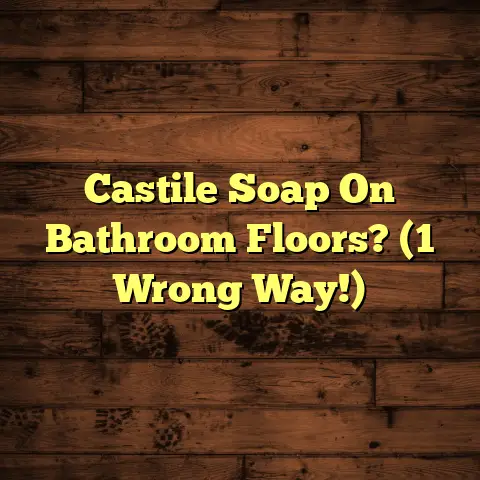Clean a Kitchen Floor? (5 Pro Secrets!)
From spilled spaghetti sauce to muddy paw prints, the kitchen floor endures a lot. And with the rise of open-concept living, our kitchens are now the heart of the home, meaning even more foot traffic and potential messes.
Keeping your kitchen floor clean isn’t just about aesthetics; it’s about hygiene and protecting your investment.
So, how do you keep your kitchen floor sparkling?
I’m going to share my top 5 pro secrets for achieving a clean and healthy kitchen environment. Ready? Let’s dive in!
1. Understanding Different Types of Kitchen Floors
First things first, you need to know what you’re dealing with. Kitchen floors come in all shapes and sizes, and each material requires a slightly different approach to cleaning.
-
Tile: Tile is a popular choice because it’s durable and water-resistant. But grout lines can be a nightmare, trapping dirt and stains.
-
Vinyl: Vinyl is budget-friendly and easy to install. It’s also water-resistant, making it a good option for kitchens. However, it can be prone to scratches and dents.
-
Hardwood: Hardwood floors add warmth and elegance to any kitchen. But they’re susceptible to water damage and scratches.
-
Laminate: Laminate is a more affordable alternative to hardwood. It’s relatively durable, but it can be damaged by excessive moisture.
Common Challenges by Flooring Type:
| Flooring Type | Common Challenges |
|---|---|
| Tile | Stains in grout, chips |
| Vinyl | Scratches, dents, fading |
| Hardwood | Water damage, scratches |
| Laminate | Moisture damage, swelling |
I once had a client with beautiful slate tile in their kitchen. They were constantly struggling with a hazy film on the surface. Turns out, they were using the wrong cleaner! A pH-neutral cleaner specifically designed for stone was the key.
2. The Importance of Regular Maintenance
Think of your kitchen floor like your car. You wouldn’t wait until the engine seizes to get an oil change, would you? Regular maintenance is crucial for extending the life of your floor and keeping it looking its best.
Why is regular cleaning so important?
-
Hygiene: Kitchen floors can harbor bacteria, germs, and food particles. Regular cleaning helps prevent the spread of illness.
-
Longevity: Dirt and grime can act like abrasives, scratching and dulling your floor’s finish over time.
-
Appearance: A clean floor simply looks better! It brightens up the entire kitchen and creates a more inviting space.
According to a study by the National Sanitation Foundation (NSF), the kitchen floor can be one of the germiest places in the home. (Source: https://www.nsf.org/)
Neglecting your floor can lead to some unpleasant consequences, including:
-
Pest Infestations: Crumbs and food scraps can attract ants, roaches, and other pests.
-
Mold Growth: Moisture trapped under mats or in grout lines can create a breeding ground for mold.
-
Permanent Stains: The longer spills sit, the harder they are to remove.
3. Pro Secret #1: The Right Tools for the Job
You wouldn’t try to build a house with just a hammer, right? The same goes for cleaning your kitchen floor. Having the right tools makes the job much easier and more effective.
Essential Cleaning Tools:
- Broom: A good broom is essential for sweeping up loose dirt and debris.
- Vacuum Cleaner: A vacuum cleaner with a hard floor attachment is great for removing dust and pet hair.
- Mop: Choose a mop that’s appropriate for your floor type. Microfiber mops are excellent for most surfaces.
- Buckets: You’ll need at least two buckets: one for clean water and one for dirty water.
- Scrub Brush: A scrub brush is handy for tackling stubborn stains and grout lines.
- Sponges and Cloths: Keep a supply of sponges and cloths for wiping up spills and cleaning surfaces.
Specialized Cleaning Equipment:
- Steam Mop: Steam mops use hot steam to sanitize and clean floors without the need for harsh chemicals. They’re great for tile, vinyl, and laminate.
- Floor Scrubber: For larger kitchens or heavily soiled floors, a floor scrubber can save you a lot of time and effort.
Eco-Friendly vs. Conventional Cleaning Products:
I’m a big advocate for using eco-friendly cleaning products whenever possible. They’re safer for your family, your pets, and the environment. Plus, they’re often just as effective as conventional cleaners.
Look for products that are:
- Biodegradable: They break down naturally and won’t pollute waterways.
- Non-Toxic: They don’t contain harsh chemicals that can irritate your skin or respiratory system.
- Plant-Based: They’re made from renewable resources.
4. Pro Secret #2: Effective Cleaning Techniques
Now that you have the right tools, let’s talk about technique. The way you clean your floor can make a big difference in the results you achieve.
General Cleaning Steps:
- Sweep or Vacuum: Remove loose dirt and debris.
- Prepare Cleaning Solution: Mix your chosen cleaning solution with warm water according to the manufacturer’s instructions.
- Mop the Floor: Dip your mop into the cleaning solution, wring out the excess water, and mop the floor in overlapping strokes.
- Rinse (Optional): Some cleaning solutions don’t require rinsing. If yours does, use clean water to remove any residue.
- Dry the Floor: Use a clean, dry mop or towel to dry the floor. This will help prevent water spots and streaks.
Cleaning Techniques for Specific Flooring Types:
- Tile: Use a grout brush to scrub grout lines with a mixture of baking soda and water or a commercial grout cleaner.
- Vinyl: Avoid using abrasive cleaners or scrub brushes, as they can damage the surface.
- Hardwood: Use a wood floor cleaner specifically designed for hardwood. Avoid using excessive water, as it can damage the wood.
- Laminate: Use a laminate floor cleaner and avoid using excessive water. Wipe up spills immediately.
Removing Stubborn Stains:
- Grease: Use a degreasing cleaner or a mixture of dish soap and water.
- Wine: Blot up the spill immediately and then apply a paste of baking soda and water.
- Coffee: Blot up the spill and then apply a mixture of vinegar and water.
- Pet Stains: Use an enzymatic cleaner specifically designed for pet stains.
Remember that pH-neutral cleaners are generally safe for stone tiles. Acidic or alkaline cleaners can etch or damage the surface.
5. Pro Secret #3: Timing Your Cleaning Routine
Timing is everything, right? When it comes to cleaning your kitchen floor, the same holds true.
Best Times to Clean:
- After Meals: Wipe up spills and crumbs immediately after meals to prevent stains and attract pests.
- Weekly Deep Clean: Schedule a weekly deep clean to remove built-up dirt and grime.
- Seasonal Deep Cleans: Do a more thorough deep clean in the spring and fall, when you’re likely to have more time.
Creating a Cleaning Schedule:
- Daily: Sweep or vacuum the floor.
- Weekly: Mop the floor.
- Monthly: Clean grout lines (if applicable).
- As Needed: Clean up spills and stains immediately.
How Timing Impacts Effectiveness:
Cleaning up spills immediately prevents them from setting in and becoming more difficult to remove. Regular cleaning prevents dirt and grime from building up and damaging your floor’s finish.
I know life gets busy, but even a quick sweep after dinner can make a huge difference in the long run.
6. Pro Secret #4: Preventative Measures
An ounce of prevention is worth a pound of cure, as they say! There are several things you can do to prevent dirt and stains from accumulating on your kitchen floor in the first place.
Preventative Measures:
- Use Mats and Rugs: Place mats at entrances to trap dirt and debris before they reach your kitchen floor. Use rugs in high- traffic areas to protect the floor from wear and tear.
- Apply Protective Coatings or Sealants: Apply a protective coating or sealant to certain flooring types to enhance durability and resistance to stains.
- Quick Clean-Ups: Wipe up spills and crumbs immediately.
- Shoe Policy: Consider implementing a “no shoes” policy in your home to reduce the amount of dirt tracked onto your kitchen floor.
- Pet Care: Keep your pet’s paws clean to prevent them from tracking dirt and mud into the kitchen.
Benefits of Protective Coatings and Sealants:
- Enhanced Durability: They protect your floor from scratches, dents, and wear and tear.
- Stain Resistance: They make it easier to clean up spills and prevent stains from setting in.
- Water Resistance: They protect your floor from water damage.
I always recommend that my clients apply a high-quality sealant to their grout lines. It makes a world of difference in preventing stains and keeping the grout looking clean.
7. Pro Secret #5: Expert Tips for Special Situations
Sometimes, you’re faced with a cleaning challenge that requires a little extra expertise. Here are some tips for tackling special situations:
Pet Stains:
- Use an enzymatic cleaner specifically designed for pet stains.
- Blot up the stain immediately.
- Apply the cleaner according to the manufacturer’s instructions.
- Let the cleaner sit for the recommended amount of time.
- Blot up the cleaner with a clean cloth.
- Rinse the area with clean water.
- Dry the area with a clean towel.
Grease Buildup:
- Use a degreasing cleaner or a mixture of dish soap and water.
- Apply the cleaner to the affected area.
- Let the cleaner sit for a few minutes.
- Scrub the area with a scrub brush or sponge.
- Rinse the area with clean water.
- Dry the area with a clean towel.
Water Damage:
- Dry the area immediately with towels or a wet vacuum.
- Use a dehumidifier to remove excess moisture from the air.
- If the damage is extensive, consider hiring a professional water damage restoration company.
When to Hire a Professional:
- If you’re dealing with a stubborn stain that you can’t remove on your own.
- If you’re dealing with extensive water damage.
- If you want to restore your floor’s finish.
- If you simply don’t have the time or energy to clean your floor yourself.
I once helped a client who had a major grease fire in their kitchen. The grease had splattered everywhere, including on the floor. It was a tough job, but with the right degreasing cleaner and a lot of elbow grease, we were able to get the floor looking like new again.
Conclusion: Reinforcing the Trend
So, there you have it – my top 5 pro secrets for cleaning your kitchen floor!
Remember, a clean kitchen floor is more than just aesthetically pleasing; it’s essential for hygiene and protecting your investment.
With the rise of open-concept living, our kitchens have become the heart of the home, making it even more important to maintain a clean and healthy kitchen environment.
By adopting these tips and tricks, you can keep your kitchen floor sparkling and enjoy a healthier, more enjoyable kitchen environment for years to come.
So, take pride in your kitchen space, invest in the maintenance of your flooring, and enjoy the benefits of a clean and beautiful home!
Happy cleaning!





